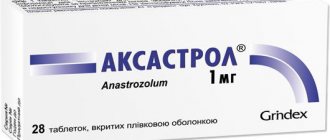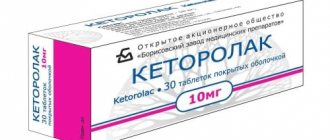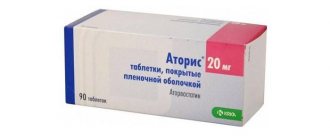Release form and composition
The dosage form of Glucovance is tablets: capsule-shaped biconvex in a film shell, light orange with an engraving on one side “2.5” or yellow with an engraving “5” (15 pieces in blisters, 2 blisters in a cardboard pack).
Content of active ingredients in 1 tablet:
- Glibenclamide – 2.5 mg or 5 mg;
- Metformin hydrochloride – 500 mg.
Excipients: povidone K30, croscarmellose sodium, magnesium stearate, microcrystalline cellulose.
Composition of the light orange/yellow shell: opadry OY-L-24808 pink/opadry 31-F-22700 yellow (hypromellose 15cP, lactose monohydrate, titanium dioxide, red iron oxide, black iron oxide/quinoline yellow dye, macrogol, iron oxide yellow), purified water.
Pharmacological properties
Pharmacodynamics
Glucovance is a fixed combination of two oral hypoglycemic agents, which belong to different pharmacological groups: glibenclamide and metformin.
Metformin is part of the biguanide group and reduces the level of both postprandial and basal glucose in the blood plasma. It does not stimulate insulin production, which results in a minimal risk of hypoglycemia. The substance is characterized by three mechanisms of action:
- inhibition of glucose absorption in the gastrointestinal tract;
- increased sensitivity of peripheral insulin receptors, increased consumption and utilization of glucose by muscle cells;
- reduction of glucose synthesis in the liver by inhibiting the processes of glycogenolysis and gluconeogenesis.
Metformin also has a beneficial effect on blood lipids, reducing the concentrations of triglycerides, low-density lipoproteins (LDL) and total cholesterol.
Glibenclamide is a second generation sulfonylurea derivative. When this active substance enters the body, the glucose level decreases due to the activation of insulin production by beta cells located in the pancreas.
The mechanisms of action of metformin and glibenclamide are different, but the substances have a synergistic effect and are able to enhance each other's hypoglycemic activity, which allows for a significant reduction in blood glucose levels.
Pharmacokinetics
Absorption of glibenclamide from the gastrointestinal tract when taken orally exceeds 95%. This active component of Glucovance is micronized. The maximum concentration of the substance in plasma is achieved in approximately 4 hours, and the volume of distribution is about 10 liters. Glibenclamide is 99% bound to plasma proteins. It is almost 100% metabolized in the liver, forming two inactive metabolites, which are excreted in bile (60% of the dose taken) and urine (40% of the dose taken). The half-life varies from 4 to 11 hours.
Metformin after oral administration is absorbed from the gastrointestinal tract quite completely, and its maximum plasma level is reached within 2.5 hours. Approximately 20-30% of the substance is excreted from the gastrointestinal tract unchanged. Absolute bioavailability is 50–60%.
Metformin is distributed into tissues at a high rate, and its degree of binding to plasma proteins is minimal. The substance is slightly metabolized and excreted through the kidneys. The half-life averages 6.5 hours. In patients with renal dysfunction, there is a decrease in renal clearance and an increase in half-life, which causes an increase in the content of metformin in the blood plasma.
The combination of glibenclamide and metformin in one preparation has the same bioavailability as when taking tablet forms containing these active ingredients separately. Food intake does not affect the bioavailability of Glucovance, which is a combination of glibenclamide and metformin. However, the rate of absorption of glibenclamide when taken with food increases.
Features of good stagnation
Lactic acidosis
Even rare, but severe metabolic disorders, which most often occur with acute loss of function of the brain, heart disease or sepsis. In case of acute loss of function, the accumulation of metformin occurs, which increases the risk of developing lactoazidosis.
In case of fever (severe diarrhea or vomiting, fever or change in stomach intake), it is recommended to immediately take the dose of metformin and seek medical help.
Patients who are weaning off metformin should be careful when using medications that may acutely impair drug function (such as antihypertensive medications, sepsis medications, and NSAIDs). Other risk factors for lactoasidosis include excessive alcohol consumption, liver failure, inadequately controlled diabetes, ketosis, fasting and other conditions associated with hypoxia, as well as concomitant constipation Suvanna medicinal treatments that can lead to lactoazidosis (div. divided “Contraindications” and “Interactions with other medicinal drugs and other types of interactions”).
Patients and/or individuals who are caring for them may be informed about the risk of developing lactic acidosis. The characteristic signs of lactoazidosis are acidotic diarrhea,
in the abdomen, muscle vessels, asthenia and hypothermia, and subsequently the development of coma. If any symptom of lactic acidosis appears, the patient should take metformin and immediately go to the doctor.
Diagnostic laboratory results – decreased blood pH (< 7.35), increased serum lactate concentration in blood plasma (> 5 mmol/l) and increased anion gap and increased serum level. term instead of lactate/piruvate.
Hypoglycemia.
The drug Glucovance
®
contains a sulfonyl resin, so that patients who are resistant to this drug are more likely to develop hypoglycemia. After starting therapy, titrating the dose of the drug may prevent the development of hypoglycemia. The drug is prescribed to patients who maintain a regular intake schedule (including drinks). Regular intake of carbohydrates is an important factor, since the risk of developing hypoglycemia increases with inappropriate intake, insufficient or unbalanced intake of carbohydrates. Hypoglycemia most often occurs in patients who are on a low-calorie diet, after intense or intense eating, when drinking alcohol, or when combining therapy with hypoglycemia in a gentle way.
Diagnostics
. Symptoms of hypoglycemia: headache, hunger, nausea, vomiting, extreme sleepiness, trouble sleeping, restlessness, aggressive attacks, impaired concentration and reaction, depression, confusion , speech defects, impaired vision, tremors, paralysis, paresthesia, confusion, delirium, seizures, drowsiness, restlessness, dizziness, bradycardia. Associated with counterregulation caused by hypoglycemia, there may be sweating, fear, tachycardia, arterial hypertension, rapid heart rate, angina and arrhythmia. These symptoms may be present throughout the day in cases of prolonged development of hypoglycemia, autonomic neuropathy, or in cases of occasional use of β-blockers, clonidine, reserpine, guanethidine, or sympathomimetics.
Treating hypoglycemia.
In case of mild symptoms of hypoglycemia without loss of speed or neurological manifestations, it is necessary to immediately take Tsukor. Make sure to adjust the dose of the drug and/or adjust the diet. Severe hypoglycemic reactions with coma, seizures and other neurological signs are possible, which can cause serious illness. This will require emergency treatment with internal glucose administration if a diagnosis or suspicion of hypoglycemia is made before the patient is hospitalized.
It is important to select patients, adjust dosage, and provide patients with the appropriate dosages to reduce the risk of developing hypoglycemia. If patients experience repeated episodes of severe hypoglycemia or episodes associated with unknown manifestations of hypoglycemia, then consider the possibility of other options in hypoglycemic treatment.
Factors associated with hypoglycemia:
- immediate consumption of alcohol, especially during hunger strikes,
- vidmova (especially in patients of the summer age) or the unrecognizability of patients against the doctor’s recommendations,
- irregular intake of food, undernutrition, missed meals, fasting or change of diet,
- inequal relationship between physical rights and carbohydrate consumption,
- nirkova lack of supply,
- Pechenkov's severe insufficiency,
- overdosing with Glucovance®
, - types of endocrine disorders: lack of function of the thyroid gland, lack of function of the pituitary gland and suprathyroid glands,
- immediate use of certain medications (section “ Interactions with other medications and other types of interactions
”).
Summer age patients
:
Ages 65 years and older have been identified as a risk factor for the development of hypoglycemia in patients who have been exposed to sulfonylated drugs. Symptoms of hypoglycemia are important to recognize in summer age patients.
To reduce the risk of development of hypoglycemia, carry out a careful correction of the dose and a supporting dose of glibenclamide (section “Method of administration and dosage”).
Nirkova and Pechinkova lack of availability
In patients, the pharmacokinetics and/or pharmacodynamics of Glucovance
®
. Since this category of patients suffers from hypoglycemia, it can become chronic and require careful treatment.
It is necessary to inform patients and their home countries about the risk of developing hypoglycemia, its symptoms and treatment, as well as the factors that cause it. It is also necessary to avoid the risk of developing lactic acidosis in the presence of non-specific symptoms, such as ulcers, swelling disorders, abdominal pain, severe asthenia, acidosis, hypothermia, coma.
With sedation, patients should be informed about the importance of early childhood, regular physical exercise, and glycemic control.
Imbalance of glucose levels in the blood.
In cases of surgical procedures or other causes of decompensation of cellular diabetes, it is necessary to undergo immediate insulin therapy. Symptoms of hyperglycemia: increased secretion, severe sprague, dry skin.
Nirok function.
The CSF should be assessed prior to harvesting and regularly after its completion (section “Method of administration and dosage”). Metformin administration is contraindicated in patients with a GFR < 30 ml/min and may be immediately prescribed due to the presence of illness, which requires changing the function of the drug (section “Contraindications”).
In such cases, it is also recommended to check the function of the drug before starting treatment with metformin.
Cardiac function
. Patients with heart failure have a risk of hypoxia and nicotine deficiency. Patients with stable chronic heart failure may be treated with Glucovance, subject to regular monitoring of heart function and function.
For patients with acute and unstable heart failure, the drug Glucovance®
contraindications (div. section “Contraindications”).
Iodine-based X-ray contrast agents
. Intravascular administration of iodine-containing contrast agents may cause contrast-induced nephropathy, leading to metformin accumulation and increased risk of lactoazidosis. For patients on stagnant metformin, start the trace before or before the hour of follow-up and do not renew it before 48 years after follow-up, unless after re-evaluation and establishment of a stable state of function (div. rose) sections “Method of administration and dosage” and “Interaction with other medicinal agents and Other types of mutual relations").
The use of glibenclamide with other medications is inappropriate.
It is not recommended to take glibenclamide simultaneously with alcohol, phenylbutazone or danazol (section “
Interactions with other medications and other types of interactions
”).
Surgical procedures
. It is necessary to stop the drug before surgical administration, such as under general, spinal or epidural anesthesia, and not to renew it before 48 years after the operation or renew it orally oh food, without re-evaluation and establishment of a stable state of the function of nirok.
Enter carefully
. Patients need to follow their diet and properly distribute their carbohydrate intake throughout the day. Patients with excess body weight should follow a low-calorie diet.
During the hour of drug therapy, exercise regularly. It is necessary to regularly monitor laboratory values (glycemia and glycosylated hemoglobin - HbA1c).
Treating patients with glucose-6-phosphate dehydrogenase deficiency due to sulfonyl hydrogenase deficiency may lead to the development of hemolytic anemia. Glibenclamide fragments are included in this class, it is necessary to freeze Glucovance with special care ®
in patients with glucose-6-phosphate dehydrogenase deficiency, consider switching to alternative therapy with drugs that do not contain similar sulfonyl compounds.
It is possible to relieve the alarming signs of low blood glucose levels if the patient suffers from autonomic neuropathy. With special care, administer the drug to patients with impaired liver function, or decreased function of the thyroid gland, pituitary gland, or measles of the suprathyroid gland. In sick summer patients, there is a high risk of developing prolonged hypoglycemia, so it is necessary to administer glibenclamide to this category of patients with special caution and carefully monitor their position on the cob. Nya. In this age-old group, sulfonyl chloride preparations with a short duration of action are more effective in the retina. Patients with diabetes with signs of cerebral sclerosis have a higher risk of developing hypoglycemia. Longer intervals between meals, insufficient carbohydrate supply, poor exercise, diarrhea and vomiting may precipitate the development of hypoglycemia. In case of repeated ingestion of alcohol at a significant level, and in the case of continuous ingestion, it is possible to strengthen or weaken the effect of the drug. Constantly being abused by passing means can lead to disruption of speech exchange. If the treatment plan is not carefully planned, the drug is insufficient, or in the presence of stressful situations, blood sugar may increase. Symptoms of hyperglycemia may include dry mouth, itching, fungal or infectious skin conditions, and decreased productivity. In non-stressful situations (trauma, surgery, infection, illness, which is accompanied by an increase in body temperature), speech metabolism may be impaired, which can lead to severe hyperglycemia, which may may result in a timely transition of the patient to insulin. Patients should be informed of the need for immediate consultation with a physician in case of the development of other illnesses during treatment with the drug. It is necessary to monitor the intake of tablets in patients, which will require special inspection.
Patients who suffer from congenital galactosemia, glucose and galactose malabsorption syndrome, lactase deficiency are contraindicated in taking the drug, containing lactose.
Contraindications
- Diabetes mellitus type 1;
- Diabetic precoma and coma;
- Diabetic ketoacidosis;
- Lactic acidosis, including a history;
- Renal and/or liver failure;
- Functional renal impairment (creatinine clearance (CC)
- Acute conditions causing changes in kidney function: severe infection, dehydration, shock, administration of intravascular iodine-containing contrast agents;
- Porphyria;
- Tissue hypoxia due to acute or chronic forms of respiratory or heart failure, shock, recent myocardial infarction;
- Pregnancy and breastfeeding period;
- Concomitant use of miconazole;
- Extensive surgical interventions;
- Acute alcohol intoxication, chronic alcoholism;
- Following a hypocaloric diet (less than 1000 kcal per day);
- Glucose-galactose malabsorption syndrome, galactose intolerance, lactase deficiency;
- Age up to 18 years;
- Age over 60 years, when performing heavy physical activity (risk of developing lactic acidosis);
- Hypersensitivity to the components of the drug or other sulfonylurea derivatives.
It is recommended to prescribe Glucovance with caution for: diseases of the thyroid gland with uncompensated impairment of its function; adrenal insufficiency; febrile syndrome; hypofunction of the anterior pituitary gland.
Contraindicated
- Increased sensitivity to metformin, glibenclamide, other components of the drug or other sulfonyl compounds, sulfonamides;
- in the form of cervical diabetes, when treatment with insulin is required: cellular diabetes type 1 (insulin-dependent cellular diabetes), repeated secondary ineffectiveness of glibenclamide therapy in cellular diabetes type 2
, etc. Iabetic precoma or coma after resection of the subglottis; - any type of acute metabolic acidosis (for example, lactic acidosis, diabetic ketoacidosis);
- severe stage nitric deficiency (glomerular filtration rate (GFR) < 30 ml/xv);
- acute illnesses that occur with a risk of development of impaired function of the body: dehydration of the body, severe infectious illness, shock;
- illness that can lead to tissue hypoxia (hypoxia, acute illness or worsening chronic illness), for example, decompensated heart failure, respiratory failure, recent myocardial infarction, shock;
- liver failure, acute alcohol intoxication, alcoholism;
- porphyria;
- period of pregnancy and breastfeeding;
- sumisne zastosuvannya with bosentan;
- Compelling therapy with miconazole (section “Interactions with other medicinal agents and other types of interactions”).
Instructions for use of Glucovance: method and dosage
Glucovance tablets are recommended to be taken with meals; the diet should contain a large amount of carbohydrates.
The doctor prescribes the dose individually, taking into account the level of glycemia.
The initial dose is 1 tablet Glucovance 2.5 mg/500 mg or Glucovance 5 mg/500 mg 1 time per day.
When transferring a patient from combination or monotherapy with sulfonylureas and metformin to treatment with Glucovance, in order to prevent hypoglycemia, the initial dose should not exceed the equivalent daily dose of previously taken drugs. To achieve adequate blood glucose control, the dose should be increased gradually, by no more than 5 mg/500 mg per day every two weeks or less frequently. Dose adjustments should always be made depending on the glycemic level.
The maximum daily dose is 4 tablets Glucovance 5 mg/500 mg or 6 tablets 2.5 mg/500 mg. The regimen for taking tablets is determined individually, it depends on the daily dose of the drug:
- 1 tablet (any dosage) – 1 time per day, in the morning;
- 2 or 4 tablets (any dosage) – 2 times a day, morning and evening;
- 3, 5 or 6 tablets of 2.5 mg/500 mg or 3 tablets of 5 mg/500 mg – 3 times a day, should be taken in the morning, lunch and evening.
For elderly patients, the initial dose should not exceed 1 tablet of 2.5 mg/500 mg. The dosage and use of Glucovance should be carried out under regular monitoring of the state of renal function.
Suspension during pregnancy or breastfeeding
Vaginism
.
Pre-clinical and clinical data on the use of Glucovance ®
during gestation on a daily basis.
Rizik, due to blood diabetes.
Uncontrolled diabetes during pregnancy (gestational or permanent) increases the risk of development of congenital anomalies and perinatal mortality. It is necessary to control blood diabetes during the pregnancy period to reduce the risk of development of congenital anomalies.
Rizik
,
relationships with metformin.
Pre-clinical studies did not reveal a negative effect on vaginity, embryonic or fetal development, and post-natal development. It is important to note that metformin should be administered to vaginal women so that they do not indicate an increased risk of congenital anomalies.
Rizik
,
binding to glibenclamide.
Glibenclamide is contraindicated for use during pregnancy. Preclinical studies did not reveal teratogenic effects. If there is a teratogenic effect in animals, but fetal development in humans is not observed, fragments of the substances that cause fetal development in humans may have a teratogenic effect on animals of two species during the investigation. In clinical practice, there are consistent data, on the basis of which an assessment of the potential effects or fetotoxicity of stagnant glibenclamide is formed during the period of gestation, daily.
Likuvannya
.
Adequate control of the level of glucose in the blood contributes to the normal balance of vaginosis in this category of patients. Do not use the drug Glucovance ®
for the treatment of diabetes during pregnancy.
In times of planned gestation, as well as in cases of actual gestation, it is recommended to switch from oral hypoglycemic therapy to insulin therapy to maintain the level of glucose in the blood as close to normal as possible. It is recommended to monitor the level of glucose in the blood of the newborn.
Goddamn breastfeeding.
Metformin passes into human breast milk,
but
in newborns/unborn babies who were breastfed during maternal monotherapy with metformin, side effects were not observed.
However, given that glibenclamide is absorbed into human breast milk every day, as well as the risk of developing hypoglycemia in the newborn, the drug is contraindicated during breastfeeding. Fertility . Metformin does not affect the fertility of animals at stagnant doses
600 mg/kg/dose, which was approximately 3 times higher than the maximum recommended dose for a person with swelling on the body surface area. Glibenclamide does not affect the fertility of animals when administered orally at doses of 100 and 300 mg/kg/dose.
Side effects
- From the digestive system: very often - lack of appetite, nausea, abdominal pain, vomiting, diarrhea. Symptoms usually appear at the beginning of therapy and are temporary. Very rarely - functional liver disorders, hepatitis;
- From the senses: often – a metallic taste in the mouth. At the beginning of therapy, temporary visual impairment is possible;
- Metabolism: hypoglycemia; rarely - attacks of cutaneous porphyria and hepatic porphyria; very rarely - lactic acidosis. With long-term therapy - a decrease in the concentration of vitamin B12 in the blood serum (can cause megaloblastic anemia). When drinking alcohol, a disulfiram-like reaction occurs;
- From the hematopoietic organs: rarely – thrombocytopenia and leukopenia; very rarely - pancytopenia, hemolytic anemia, bone marrow aplasia, agranulocytosis;
- From the skin: rarely – itching, measles-like rash; very rarely - exfoliative dermatitis, erythema multiforme, photosensitivity;
- Allergic reactions: rarely - urticaria; very rarely - visceral or cutaneous allergic vasculitis, anaphylactic shock. With simultaneous use, manifestations of cross-hypersensitivity to sulfonamides and their derivatives are possible;
- Laboratory indicators: infrequently - an increase in the concentration of creatinine and urea in the blood serum to a moderate degree; very rarely - hyponatremia.
Side effects
The most common unwanted reactions to eating cob are boredom, vomiting, diarrhea, abdominal pain, and loss of appetite. These symptoms go away on their own in most seizures. To prevent the occurrence of side effects, it is recommended to increase the dosage and increase the dosage of the drug in 2-3 doses. A possible development of short-term disruptions to the eye of the cob is associated with a decrease in glycemic levels.
It was reported about the development of adverse reactions when taking the drug Glucovance®
. Unnecessary effects according to frequency are classified into the following categories: very often (> 1/10), often (> 1/100 and < 1/10), infrequently (> 1/1000 and < 1/100), rarely (> 1/10) 10000 and < 1/1000), even rare (< 1/10000).
On the side of the blood and lymphatic system.
Reversal reactions that occur after treatment.
Rarely: leukopenia, thrombocytopenia.
Very rare: agranulocytosis, hemolytic anemia, cerebrovascular aplasia, pancytopenia.
Exchange of speeches
.
Hypoglycemia (division “Peculiarities of Stagnation”).
Uncommon: hepatic porphyria, skin porphyria.
Very rare: lactic acidosis (div. section “Peculiarities of stagnation”).
When taking metformin for a long period of time, the absorption of vitamin B12 may decrease, which is accompanied by a decrease in its level in blood syringation. It is recommended to consider this etiology if the patient has obvious megaloblastic anemia.
Disulfiram-like reaction when ingested with alcohol.
On the side of the nervous system.
Often: ruining the relish.
From the side of the organs.
Short-term disorders of the eye can lead to a decrease in the level of glycemia.
On the side of the grass path
.
Very often: disorders of the herbal system, including fatigue, vomiting, diarrhea, abdominal pain, loss of appetite. Most often, these side effects occur at the beginning of the treatment and, as a rule, arise spontaneously. To prevent the onset of side effects from the herbal system, it is recommended to increase the dosage and ingest the drug 2-3 times per dose.
On the side of the skin and under the skin.
Cross-reactivity to sulfonyl compounds or similar ones.
Rarely: skin reactions, including itching, urticaria, maculopapular visip.
Very rarely: skin or visceral allergic vasculitis, erythema multiforme, exfoliative dermatitis, photosensitivity, urticaria, which leads to the development of shock, erythema.
On the side of the stove
.
Very rarely: impaired liver function or hepatitis, which will require immediate treatment.
Follow-up
.
Uncommon: moderate elevation of blood serum levels and creatinine in blood serum.
Very rare: hyponatremia.
Overdose
An overdose of Glucovance can provoke the development of hypoglycemia, since the drug contains a sulfonylurea derivative.
Symptoms of mild to moderate hypoglycemia in the absence of central nervous system disorders and syncope are usually corrected by prompt consumption of sugar. You should also adjust the dose of Glucovance and/or change your diet. If patients with diabetes mellitus experience severe hypoglycemic reactions accompanied by paroxysm, coma or other neurological disorders, emergency medical care must be provided. Immediately after diagnosis or at the slightest suspicion of hypoglycemia, immediate intravenous administration of dextrose solution is recommended before the patient is admitted to the hospital. After the patient has regained consciousness, he should be given food rich in carbohydrates that are easily digestible, which will prevent the recurrence of hypoglycemia.
Long-term use of Glucovance in high doses or existing associated risk factors can lead to the development of lactic acidosis, since the drug contains metformin. Lactic acidosis is considered a condition requiring emergency medical care, and its treatment should be carried out exclusively in a hospital setting. The most effective methods of therapy that promote the elimination of lactate and metformin include hemodialysis.
In patients with liver dysfunction, the plasma clearance of glibenclamide may increase. Since this substance binds intensively to plasma proteins, its elimination during hemodialysis is unlikely.
special instructions
It is recommended to accompany treatment with regular monitoring of fasting and postprandial blood glucose levels.
During the period of taking Glucovance, it is necessary to take into account the possibility of developing lactic acidosis; signs of the disease may include the appearance of abdominal pain, severe malaise, muscle cramps and dyspeptic disorders.
When using Glucovance, there is a risk of developing hypoglycemia; it is most likely to occur in patients on a low-carbohydrate diet, who do not follow a diet, who drink alcohol, or who undergo heavy physical activity on a hypocaloric diet. Caution in prescribing, carefully selecting the dose and following the doctor’s recommendations reduce the likelihood of illness.
Alcohol consumption is prohibited during therapy.
Before prescribing Glucovance and during the period of use, it is necessary to regularly conduct studies to determine the level of creatinine concentration in the blood serum. The analysis should be performed in patients with normal renal function at least once a year, with functional renal impairment and in elderly patients - 2-4 times a year.
If infectious diseases of the bronchi, lungs or genitourinary organs appear, you should immediately consult a doctor.
Impact on the ability to drive vehicles and complex mechanisms
Patients should be careful when driving vehicles and performing other activities that require increased concentration and high speed of psychomotor reactions.
Use during pregnancy and lactation
Pregnancy is a contraindication to the use of Glucovance. Patients should be informed that during treatment with the drug they should inform the doctor about planning pregnancy or its occurrence. In both of these cases, Glucovance is immediately discontinued and a course of insulin therapy is prescribed.
There is no information on the ability of metformin in combination with glibenclamide to pass into breast milk, so prescribing the drug during lactation is unacceptable.
Drug interactions
Taking Glucovance should be stopped 2 days before and resumed 2 days after intravenous administration of iodine-containing contrast agents.
Concomitant use with miconazole is prohibited due to the high likelihood of developing hypoglycemia, even to the point of coma.
The combination of the drug with ethanol-containing drugs and phenylbutazone is not recommended, as they increase the hypoglycemic effect of Glucovance.
When used simultaneously with bosentan, the risk of hepatotoxicity increases and the effect of glibenclamide decreases.
A high dose of chlorpromazine reduces insulin release, promoting an increase in glycemic levels.
The hypoglycemic effect of Glucovance is reduced when combined with glucocorticosteroids, tetracosactide, diuretics, danazol and beta2-adrenergic agonists.
When taken simultaneously with angiotensin-converting enzyme (ACE) inhibitors, including enalapril and captopril, a decrease in blood glucose occurs.
Particular caution is required in combination with metformin in patients with functional renal failure, since while taking “loop” diuretics, there is a high probability of developing lactic acidosis.
The combination of Glucovance with sympathomimetics, beta-blockers, reserpine, clonidine, guanethidine hides the symptoms of hypoglycemia.
Dose adjustment of the drug is necessary when taking fluconazole; there is a risk of developing hypoglycemia.
Glibenclamide reduces the antidiuretic effect of desmopressin.
The hypoglycemic effect of Glucovance increases with simultaneous use with monoamine oxidase inhibitors (MAOIs), sulfonamides, anticoagulants (coumarin derivatives), fluoroquinolones, chloramphenicol, pentoxifylline, lipid-lowering drugs from the group of fibrates, disopyramide.
Overdose
Overdose can lead to the development of hypoglycemia, since the drug contains sulfonyl hydroxide (section “Peculiarities of dosage”). Significant overdose of metformin or the presence of accompanying risk factors can lead to the development of lactic acidosis (section “Peculiarities of stasis”). Lactic acidosis is not very serious and should be treated at the hospital. The most effective approach for removing lactate and metformin from the body is hemodialysis.
Plasmovium k
The release of glibenclamide may be discontinued in patients
with liver disease
.
Due to its strong binding to proteins, glibenclamide should not be removed during hemodialysis.
Reviews of Glucovance
Patients with diabetes often leave reviews about Glucovance online. They often discuss issues related to the selection of the dose and treatment regimen, as well as its combined use with other drugs. However, the reviews themselves are quite contradictory. Reports mention that to achieve the maximum effect of treatment, it is necessary to count calories and carbohydrate intake, as well as carefully follow the dosage of drugs.
However, there are also opinions about the uselessness of Glucovance. Patients complain of a lack of improvement in well-being and significant deviations from the normal value of blood sugar concentration (hypoglycemia). Other patients report that in order to normalize their health, they had to resort to long-term and careful adjustments to their treatment regimen and lifestyle.





